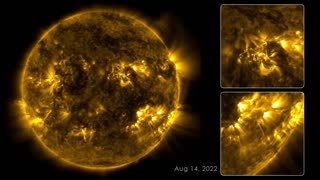133 Days on the Sun
The Sun, our nearest star, has fascinated humanity for centuries. Its immense energy output, scorching temperatures, and enigmatic processes have inspired scientific exploration and captivated the human imagination. As we delve into the heart of this fiery celestial body, let us embark on a remarkable journey to understand the Sun's inner workings, its vital role in sustaining life on Earth, and the cutting-edge research that continues to unlock its secrets.
A Glimpse into the Sun's Core
At the core of the Sun lies an astonishing fusion furnace, where hydrogen atoms collide under extreme pressure and temperatures, creating helium and releasing an immense amount of energy in the form of light and heat. This process, known as nuclear fusion, powers the Sun and sustains its luminosity. Incredibly, it takes roughly 133 days for energy generated at the core to reach the Sun's surface before being emitted as sunlight.
Layers of the Sun
The Sun is composed of several distinct layers, each with its own unique properties and characteristics. The innermost layer, the core, is a seething cauldron of nuclear reactions. Surrounding the core is the radiative zone, where energy is transported primarily through radiation. Further out, in the convective zone, heat rises and falls in massive convection currents, resembling the movement of boiling water in a pot.
Above the convective zone lies the photosphere, the visible surface of the Sun that emits the light we perceive. The photosphere is speckled with dark sunspots, which are cooler regions caused by the Sun's magnetic activity. Extending beyond the photosphere is the chromosphere, a thin layer of hot, glowing gases. Finally, the corona, an outermost layer, emits the Sun's outer atmosphere and becomes visible during solar eclipses, displaying its strikingly beautiful and intricate patterns.
The Solar Dynamo: Unraveling Magnetic Mysteries
The Sun's dynamic magnetic field is a driving force behind many of its fascinating phenomena. Solar flares, prominences, and coronal mass ejections are all results of magnetic interactions. Researchers are working tirelessly to comprehend the solar dynamo – the process by which magnetic fields are generated and sustained within the Sun's interior. By understanding the solar dynamo, scientists hope to predict solar activity more accurately, which is crucial for safeguarding our technologically dependent society from the potential hazards of solar storms.
Impact on Earth and Beyond
The Sun's influence extends far beyond its dazzling appearance. Its energy, in the form of sunlight, powers Earth's climate and ecosystems. The Sun's gravitational pull keeps our planet and other celestial bodies in check, maintaining the delicate balance of our solar system.
However, the Sun's energy can also pose challenges. Solar flares and coronal mass ejections can release massive amounts of charged particles into space, which, when directed towards Earth, can disrupt communication systems, power grids, and satellite operations. Scientists and engineers continuously develop strategies to mitigate these potential threats and improve space weather prediction.
Unveiling the Sun's Secrets: Contemporary Research
Modern instruments and technologies, such as space-based observatories and advanced computer simulations, allow scientists to delve deeper into the Sun's mysteries than ever before. NASA's Parker Solar Probe, launched in 2018, is on a daring mission to "touch" the Sun's corona, providing unprecedented insights into the solar wind and the Sun's outer atmosphere.
-
 59:17
59:17
beyondthelens788
9 months ago133 Days on the Sun
2 -
 59:17
59:17
Shahid0fficial
9 months ago133 Days on the Sun
2 -
 59:17
59:17
qazal033
9 months ago133 Days on the Sun
2 -
 59:17
59:17
DigitalSpace1
1 year ago133 Days on the Sun
14 -
 59:17
59:17
WadeParker47
1 year ago133 Days on the Sun
31 -
 59:17
59:17
PUBG TRICKS
9 months agoDays on the Sun
11 -
 59:17
59:17
MyCompany1980
9 months ago133 Days on the Sun
17 -
 59:17
59:17
ScienceTecho
9 months ago14263_133_Days_on_the_Sun_1080
3 -
 59:17
59:17
TechUniverseTV - Exploring the Limitless Frontiers of Technology
9 months ago133 Days on the Sun
14 -
 59:17
59:17
Jokser
1 year ago133 days on the Sun
2